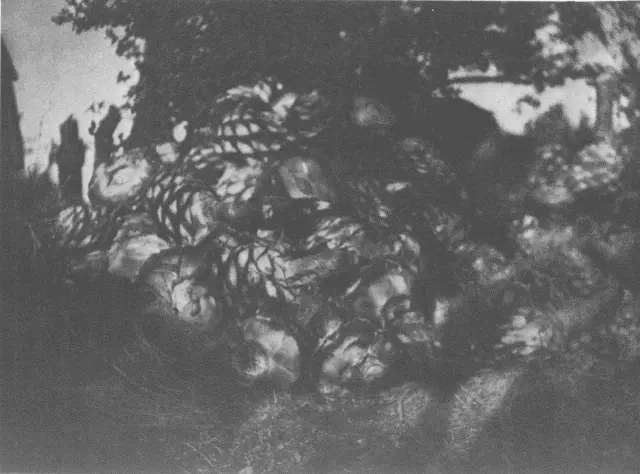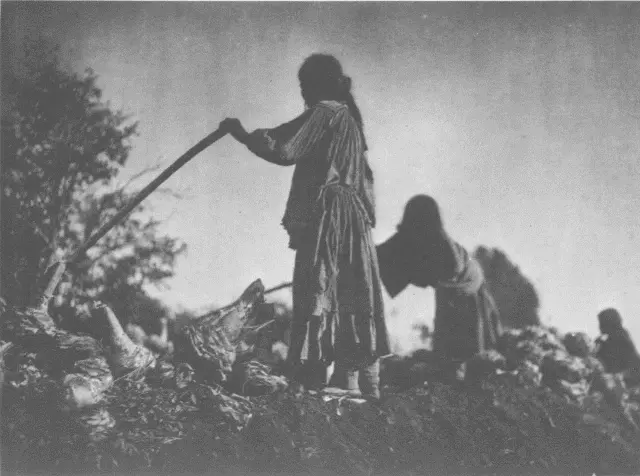From far down the stream resound the splash of water and the merry laughter of matrons and maidens bathing in the clear pools, and from above the more boisterous shouts of men and boys. Surely he who says the American Indian is morose, stolid, and devoid of humor never knew him in the intimacy of his own home.
With the coming of light the women are at work building the campfires, and the rising sun finds them at their morning meal. The breaking of camp is a brief task. To-day they are to cross the divide, ford Black river, and continue on to the mountains where the mescal grows abundantly. Travel in the cool morning hours is a delight, and seven o'clock finds the party well on its way. The long cavalcade winds slowly over the mountain trail. Just ahead is a mother with two children, a little girl astride behind her and a two-year-old boy standing in her lap. The mourning dove sounds its melancholy note from the forest, and the children take up the call. The little boy is not very proficient in the imitation, and sister corrects him time after time. Truly, in Indian-land, nature study begins early in life.
There is noticeable change in the vegetation. The giant yuccas appear almost as a forest to-day; yesterday there was none. Soon the party gains the summit of the range, before which winds the valley of the Black with miles of placid stream in view. Quite different is this from White river, which is ever hurrying, rushing along. The Black flows within its grassy banks for long distances with scarcely a ripple; then a whirling rapid is passed, beyond which glides another long stretch of almost silent water.
However, mescal does not grow by cool streams, and the trail again leads up into high mountains. On a broad slope well toward the summit the final halt is made. Close by is the mescal pit, perhaps twenty feet in diameter and three feet deep; it may have been used a hundred years or a thousand, abandoned for a long period, and then brought into use again. Each time it is employed it must first be cleaned of the refuse from the last burning; this done, a large supply of fuel is gathered and thrown in, and over all are piled great quantities of stones.
Then begins the harvest of the mescal. With baskets on their backs the women go out to gather the plants. Their implements consist of a stick about two inches in diameter and three feet long, wedge-shaped and sharpened at one end, and a broad hatchet-like knife. On reaching a plant, the woman places the sharp end of the stick at its base and by a blow with a stone severs the root and pries it up. Nothing could be more primitive. The women of the Stone Age who gathered mescal on the same ground, and perhaps used the same pit, thus far must have used identical tools.

Mescal - Apache
When the plant is cut from its root it is turned over and trimmed. For the latter the women employ the hatchet-like knife, cutting off the outer ends of the leaves. The plant now resembles a large head of cabbage and weighs from five to twenty pounds. As fast as the plants are cut the women place them in the burden baskets and carry them to the pit, load after load. To make it possible for each woman to identify her mescal after the cooking, each piece is branded with a distinguishing device—a property mark. The gathering of the mescal continues for several days, an area covering a radius of perhaps two miles being stripped of its budding plants, for such only are harvested.
The pit being ready and the mescal gathered, the work of cooking commences. Just at daylight the old woman in charge takes her place at the rim of the pit and prays that the cooking may be successful and that the people may be in condition to partake of the food. In igniting the fuel the old-fashioned fire-sticks must be employed; to use matches would bring ill fortune. When the fuel in the pit becomes a blazing mass the women go to prepare breakfast, but are soon at work again gathering brush and grass to cover the mescal. Within four hours the fuel is entirely consumed and the red-hot stones have settled to the bottom of the pit. When it is certain that no fuel remains unburned, as even a small amount of smoke would spoil the quality of the mescal, the head-woman says, "It is good," and with great eagerness her followers begin to fill the pit. There is need for haste in throwing in and covering the mescal, as the steam must be confined to prevent the hot stones from scorching it. The covering consists of alternate layers of green brush, grass, dry leaves, and finally a layer of earth, about six inches in thickness. After forty-eight hours of steaming the seething mass is uncovered and each woman removes her portion.
The greater part of the product of this cooking is now to be prepared for winter use by pulling the leaves apart and pounding them into pulp. This can be kneaded and handled much the same as dough, and while in this plastic state is formed into large cakes two inches thick and perhaps three feet long. These are dried in the sun, when they have all the appearance of large slabs of India rubber, and are easily packed on horses for the homeward journey.
This dried mescal may be eaten without further preparation, but it is generally made into a gruel by mixing with water. Alone it is very sweet, and berries of the aromatic sumac, and frequently walnuts, are crushed with it to give it flavor.
The fruit of the opuntia, or prickly-pear cactus, which the Apache call hush, is much used for food both in its fresh state and dried. It is picked from the plant with pincers of split sticks. When the tú̆tza, or burden basket, is filled its contents are poured on the ground and the fruit is brushed about with a small grass besom until the spines are worn off. In preparing hush the women grind seeds and pulp into a mass, thus retaining the full food value of the fruit.
Manzanita, piñon nuts, juniper berries, acorns of the scrub oak, fruit of the yucca, wild potatoes, wild onions, mesquite pods, and many varieties of fungi also furnish food. As a drink the Apache make a tea from the green or dried inner bark of the piñon.
The intoxicant and curse of their lives is túlapai, or tizwin as it is sometimes called. Túlapai means "muddy or gray water." It is, in fact, a yeast beer. In preparing it corn is first soaked in water. If it be winter time the wet corn is placed under a sleeping blanket until the warmth of the body causes it to sprout; if summer, it is deposited in a shallow hole, covered with a wet blanket, and left until the sprouts appear, when it is ground to pulp on a metate. Water and roots are added, and the mixture is boiled and strained to remove the coarser roots and sprouts. At this stage the liquid has the consistency of thin cream soup. It is now set aside for twenty-four hours to cool and ferment, when it is fit for drinking. As the túlapai will spoil in twelve hours it must be drunk quickly. Used in moderation it is not a bad beverage, but by no means a pleasant one to the civilized palate. The Apache, however, knows no moderation in his túlapai drinking. He sometimes fasts for a day and then drinks great quantities of it,—often a gallon or two—when for a time he becomes a savage indeed.

Filling the Pit - Apache
Another intoxicant, more effective than túlapai, is made from the mescal—not from the sap, according to the Mexican method, but from the cooked plant, which is placed in a heated pit and left until fermentation begins. It is then ground, mixed with water, roots added, and the whole boiled and set aside to complete fermentation. The Indians say its taste is sharp, like whiskey. A small quantity readily produces intoxication.
Читать дальше














